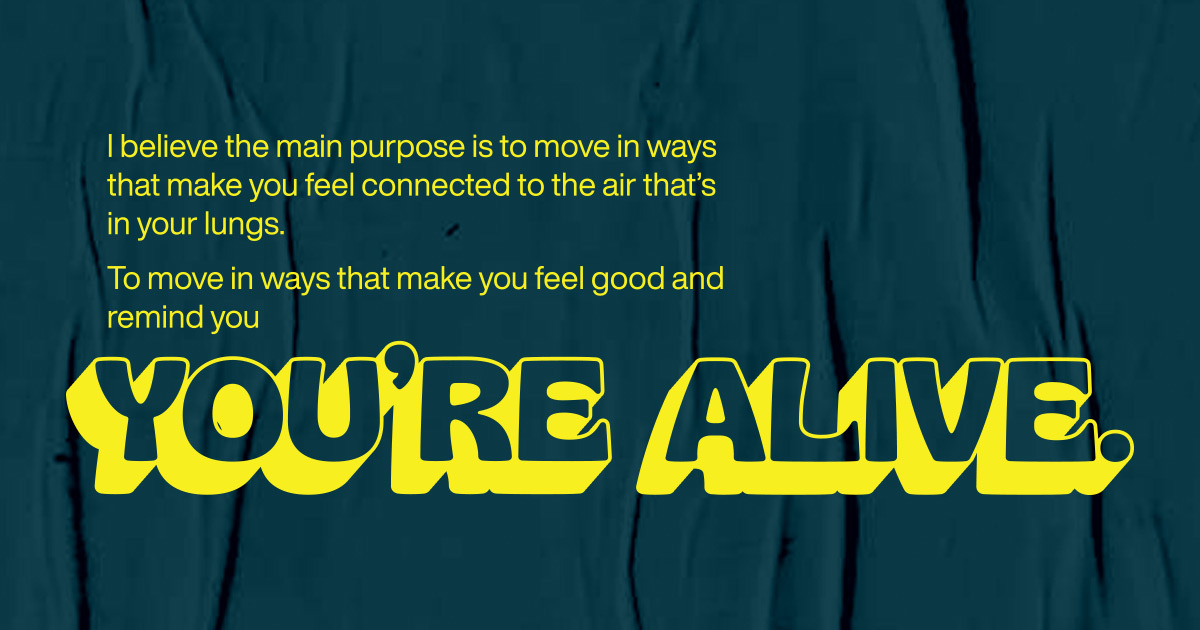Movement—or my relationship with physical fitness—has looked different over the years.
At times it was my identity, in a way that wasn’t good. It made me feel less than if I wasn’t doing the most or the best. In other seasons, it’s what grounded me. It showed me just how strong I was. How thankful I am to have air in my lungs.
Above all else, my journey with movement has been about finding that balance.
I was a collegiate athlete. And before that, I played as many sports on as many teams as I could. I had some tough things happen when I was growing up that made it unideal for me to exist in a world that didn’t allow me to channel that grief and frustration into something. Thankfully, I had sports. But there are a lot of things that can disorient you in competitive sports. They can eat you alive if you’re not careful. Fast forward to playing college soccer, and that’s when it got toxic. I was consumed by it and didn’t have the tools yet to separate my self-worth from my performance—that’s when my mental health suffered.
I didn’t know what it meant or really even looked like to have balance. I’m an all-in kind of gal which means balance is not a natural component of my personality. I needed help crawling out of the whirlwind I found myself in. I was struggling. I was pushing my body to its limits in a really unhealthy way.
You see, I love working hard. I love challenges. I love feeling intimidated by something. That’s who I am. But this was different. The thing I loved was starting to turn into something monster-like. I was doing it for validation and overworking myself out of fear. Because of this, my mental health was suffering. And although I wanted to keep doing the thing that I loved, I needed to reframe and reexamine its influence in order to care for, address, and protect my mental well-being.
So in the years following college soccer, I spent energy exploring and building the relationship between my physical health and my mental health. I needed to find the things that brought me both joy and made me feel empowered in my body. That’s when I sought out some new ways to move. I looked for things that challenged me in a new and different way than just “pushing” so hard all the time.
I tried yoga, where you connect your breath to your body. The first time I took a class, it was a bit of a culture shock. At this point, I was used to some combo platter of pure exhaustion in any form of movement and a mentality of “you’re not good enough until you exhaust your body.” So an invitation to slow down, stretch, and notice my body in a gentle way felt foreign. But eventually, it became one of the best invitations for me to open up emotionally. Ultimately, I think I craved something that allowed me to feel strong but also gave me the permission to not have to be strong if I didn’t truly want to.

What really changed my relationship with my physical and mental health was having a miscarriage. That was the first time it felt like my body had failed me. It’s a very normal human experience to question whether your body is a friend or foe. This questioning just looks different. Regardless of our identity, stature, abilities, or gender, so many of us carry things that can make us uncomfortable in our own skin. Things like not appreciating what we see in the mirror, injuries that take us away from doing the things we love, feeling as though the body we have doesn’t belong to us, or having a body that’s ill. When I felt that my body had betrayed me, it led me unexpectedly to a sense of freedom. Freedom from the expectations I was still placing on myself. Instead of seeing my body as a machine, I now saw it through a new lens that allowed for compassion and gratitude—even amidst the grief.
I began believing my body didn’t have to be perfect to be good. And the belief changed the way I moved.
My journey with movement is now about chasing the things that make me feel alive. Some days that’s going for a walk with my toddler. Some days that’s squatting as much as I can, pushing myself. It’s looked like not working out consistently for a year so I could rest and take care of myself after giving birth and during a pandemic. It’s also looked like setting goals to work out six days a week when I have energy that needs to be released. It’s balancing my needs in the midst of each unique season and finding the movement that will help me feel grounded and cared for.
Your relationship with physical health doesn’t have to look a certain way for it to work or make sense. There are a million suggestions in our world on how to do it. But I believe the main purpose is to move in ways that make you feel connected to the air that’s in your lungs. To move in ways that make you feel good and remind you you’re alive.
We believe caring for ourselves and others includes the whole self—the brain and the body. You’re invited to explore this dynamic through our Run For It 5k on April 23—an event where thousands run, roll, walk, ride, dance, swim, or move as a way to showcase just how much hope and help matter to them.